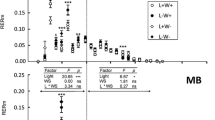Abstract
Effects of the length: width ratio of a leaf blade and petiole length on shoot light capture were studied with computer simulation. Both a larger length: width ratio and longer petiole contributed to larger light capture per unit leaf area due to a reduced aggregation of leaf area around the stem. Other conditions being equal, shoots with narrow leaves and no petioles and those with wide leaves with petioles showed similar light capture as long as the mean distance of the leaf blade from the stem was the same. In shoots with a short internode and/or distichous phyllotaxis, however, narrow leaves contributed more to avoiding mutual shading than wide leaves with petioles. The predominance of light coming from a higher angular altitude also favored narrow leaves. The possible consequences of these results in the adaptive geometry of plant architecture are discussed.
Similar content being viewed by others
References
Chazdon R. L. (1985) Leaf display, canopy structure and light interception of two understory palm species.American Journal of Botany 72: 1493–1502.
Givnish T. J. (1979) On the adaptive significance of leaf form. In:Topics in Plant Population Biology (eds O. T. Solbrig, S. Jain, G. B. Johnson & P. H. Raven) pp. 375–407. Columbia University Press, New York.
Givnish T. J. (1984) Leaf and canopy adaptations in tropical forests. In:Physiological Ecology of Plants of the Wet Tropics (eds E. Menina, H. A. Mooney & C. Vazquez-Yanes) pp. 51–84. Dr Junk Publisher, The Hague.
Givnish T. J. (1987) Comparative studies of leaf form: Assessing the relative roles of selective pressures and phylogenetic constraints.New Phytologist 106 (Suppl): 131–60.
Givnish T. J. &Vermeij G. J. (1976) Size and shapes of liane leaves.American Naturalist 110: 743–778.
Horn H. S. (1971)The Adaptive Geometry of Trees. Princeton University Press, Princeton.
King D. A. (1990) Allometry of saplings and understorey trees of a Panamanian forest.Functional Ecology 4: 27–32.
Kohyama T. (1987) Significance of architecture and allometry in saplings.Functional Ecology 1: 399–404.
Kohyama T. &Hotta M. (1990) Significance of allometry in tropical saplings.Functional Ecology 4: 515–521.
Niklas K. J. (1988) The role of phyllotactic pattern as a ‘developmental constraint’ on the interception of light by leaf surfaces.Evolution 42: 1–16.
Niklas K. J. (1989) The effect of leaf-lobing on the interception of direct solar radiation.Oecologia 80: 59–64.
Reifsnyder W. E., Furnival G. M. &Horowitz J. L. (1971) Spatial and temporal distribution of solar radiation beneath forest canopies.Agricultural Meteorology 71: 21–37.
Takenaka A. (1987) Analysis of light transmissivity of forest canopies with a telephoto method.Agricultural and Forest Meteorology 40: 359–369.
Turton S. M. (1992) Understorey light environments in a north-east Australian rain forest before and after a tropical cyclone.Journal of Tropical Ecology 8: 241–252.
Author information
Authors and Affiliations
About this article
Cite this article
Takenaka, A. Effects of leaf blade narrowness and petiole length on the light capture efficiency of a shoot. Ecol. Res. 9, 109–114 (1994). https://doi.org/10.1007/BF02347485
Received:
Accepted:
Issue Date:
DOI: https://doi.org/10.1007/BF02347485




